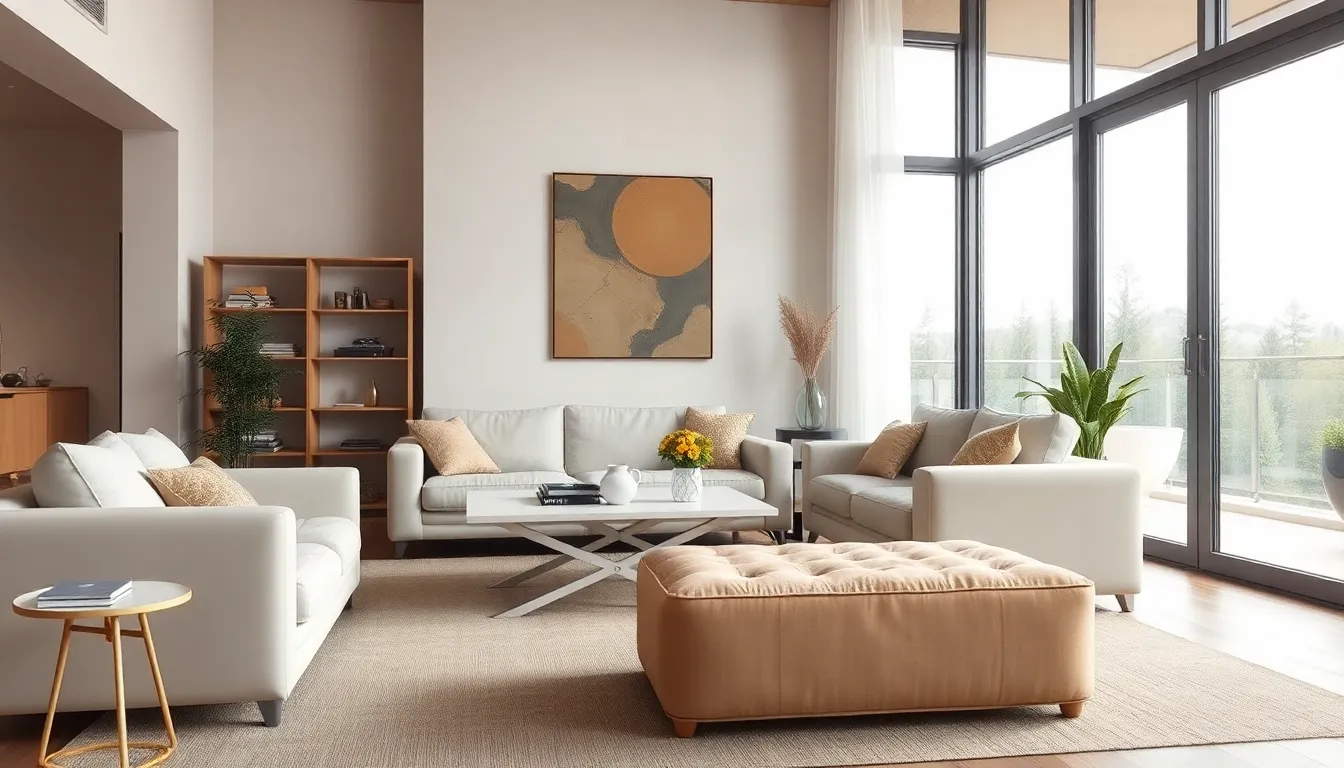In a world overflowing with stuff, minimalist furniture swoops in like a superhero ready to save the day. Imagine a living space where every piece has a purpose, and clutter is a thing of the past. It’s like a breath of fresh air for your home, making it feel lighter and more inviting. Who wouldn’t want to kick back in a room that screams “serenity” instead of “storage wars”?
Minimalist furniture isn’t just about looking sleek; it’s about embracing a lifestyle that values simplicity and functionality. With clean lines and smart designs, these pieces can transform any space into a modern oasis. So why not trade in that bulky sofa for something that fits your vibe? Your home—and your sanity—will thank you for it.
Table of Contents
ToggleWhat Is Minimalist Furniture?
Minimalist furniture emphasizes simplicity and functionality, focusing on essential elements while eliminating excess. This design approach creates a calming environment that encourages a clutter-free lifestyle.
Definition and Characteristics
Minimalist furniture showcases clean lines and a lack of ornamentation, emphasizing form over decorative details. Streamlined shapes define its appearance, creating a sense of openness. Materials like wood, metal, and glass often feature in these pieces, promoting durability and ease of maintenance. Color palettes remain neutral, enhancing the serene atmosphere. A key characteristic is the multifunctionality of each item, allowing for efficient use of space without sacrificing style.
Historical Context
The minimalist furniture movement emerged in the mid-20th century, influenced by modernist architecture and design principles. This style gained traction in the 1950s and 1960s as a response to the complexities of post-war society. Designers like Ludwig Mies van der Rohe and Charles Eames pioneered minimalist aesthetics through their innovative creations. As urban living spaces became smaller, the demand for space-saving, functional designs increased. Minimalism transformed from a design trend into a lifestyle choice, shaping contemporary interiors.
Benefits of Minimalist Furniture

Minimalist furniture offers various advantages that enhance living spaces. It plays a crucial role in creating order and tranquility while remaining functional and stylish.
Space Optimization
Space optimization stands out as a primary benefit of minimalist furniture. The design emphasizes simplicity, which helps maximize available areas. Smartly designed pieces often feature multifunctionality, allowing for multiple uses without clutter. Items like foldable tables or storage ottomans conserve floor space while providing essential functions. By reducing bulky furniture, rooms appear larger and less congested, creating an open atmosphere that’s inviting.
Aesthetic Appeal
Aesthetic appeal significantly enhances the charm of minimalist furniture. Clean lines and a lack of ornamentation create a sleek and modern look that integrates seamlessly into any decor style. Thoughtfully designed pieces capture attention through simplicity rather than excess. Neutral colors dominate this aesthetic, contributing to a serene backdrop that complements various color palettes. Designers aim for balance and harmony, making minimalist furniture not only practical but visually striking in a contemporary setting.
Popular Materials Used
Minimalist furniture utilizes various materials to enhance its simplicity and functionality. Each material contributes uniquely to the overall aesthetic and practicality of minimalist designs.
Wood
Wood remains a popular choice for minimalist furniture due to its versatility and warmth. Many designers favor hardwoods like oak, walnut, and maple for their durability and aesthetic appeal. The natural grain patterns of wood add character without overwhelming a space. Whether in the form of a sleek dining table or a simple bookshelf, wood provides a timeless quality that easily suits various decor styles. Additionally, it can be finished in neutral tones, ensuring it complements the minimalist ethos.
Metal
Metal offers a modern edge in minimalist furniture collections. Stainless steel and powder-coated aluminum are commonly used for their strength and minimalist look. These materials often feature in frame constructions for tables and chairs, enhancing stability while maintaining a light visual footprint. The sleek surface of metal aids in creating clean lines throughout a space. Furthermore, metal finishes are easily incorporated into other design elements, providing a contrasting texture to softer materials like wood and fabric.
Fabric
Fabric choices play a crucial role in the comfort of minimalist furniture. Natural fibers like linen and cotton are favored for their breathable qualities and sustainability. Minimalist sofas and chairs often use upholstery that emphasizes muted colors to maintain a serene environment. Soft fabrics enhance the inviting nature of a minimalist room without detracting from its simplicity. Additionally, synthetic options offer durability and come in an array of hues, catering to different preferences while maintaining the minimalist aesthetic.
Minimalist Furniture Styles
Minimalist furniture comes in various styles, each reflecting simplicity and functionality. Let’s explore two popular styles: Scandinavian and Japanese.
Scandinavian
Scandinavian design highlights functionality and simplicity. Furniture pieces often feature clean lines and organic shapes, emphasizing comfort. Light woods like birch and ash are common materials, adding warmth to spaces. Neutral color palettes create an airy atmosphere, making rooms feel serene. Designers incorporate natural light, ensuring spaces remain uncluttered. Versatile pieces often serve multiple purposes, such as a coffee table that doubles as storage. The style promotes a coziness known as “hygge,” encouraging relaxation and connection. Overall, Scandinavian furniture complements minimalist aesthetics effortlessly.
Japanese
Japanese minimalist furniture prioritizes beauty in simplicity and craftsmanship. This style embraces a philosophy of “ma,” the space between objects, fostering tranquility. Wooden elements, particularly from species like cedar and pine, contribute to harmony in home settings. Low-profile furniture often maximizes floor space while inviting interaction. Shoji screens, tatami mats, and futons reflect traditional elements, merging functionality with cultural significance. Color schemes tend to be muted, allowing natural materials to shine. Finally, Japanese design emphasizes a strong connection to nature, incorporating plants and natural light effectively.
Tips for Choosing Minimalist Furniture
Choosing minimalist furniture requires thoughtful consideration of several key factors. Effective selection enhances both functionality and aesthetic appeal within a living space.
Assessing Space
Evaluating available square footage is crucial. Identify areas that require furniture to maximize utility. Measuring dimensions ensures that pieces fit together seamlessly. Small apartments benefit from transforming furniture, such as expandable tables. Larger spaces can still embrace minimalism by avoiding overcrowding with oversized items. Open layouts thrive on strategically placed elements to maintain a spacious feel. Prioritize functionality while ensuring the room remains uncluttered.
Functionality vs. Aesthetics
Making choices between functionality and aesthetics can be challenging. Seek furniture pieces that offer both practical use and visual appeal. Multi-functional items, like storage benches or sofa beds, integrate seamlessly into minimalist designs. Beautifully crafted wood tables attract attention while serving as functional surfaces. Color schemes should remain neutral to reinforce simplicity. Consider how each piece contributes to overall harmony and comfort. Maintain balance between eye-catching styles and essential everyday utility.
Embracing minimalist furniture can transform any living space into a tranquil haven. By prioritizing simplicity and functionality, individuals can create environments that not only look appealing but also promote a sense of well-being. The thoughtful selection of streamlined pieces allows for greater space optimization and enhances the overall aesthetic of a home.
Incorporating minimalist designs reflects a commitment to a lifestyle that values clarity and purpose. As more people seek to declutter their lives, minimalist furniture stands out as a practical and stylish choice that meets the demands of modern living. Ultimately, this approach fosters a harmonious balance between form and function, making it an ideal solution for those looking to elevate their interiors.






